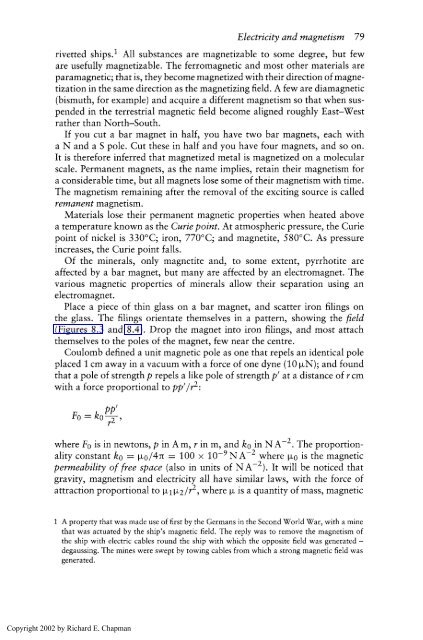Physics for Geologists, Second edition
Physics for Geologists, Second edition
Physics for Geologists, Second edition
Create successful ePaper yourself
Turn your PDF publications into a flip-book with our unique Google optimized e-Paper software.
Electricity and magnetism 79<br />
rivetted ships.l All substances are magnetizable to some degree, but few<br />
are usefully magnetizable. The ferromagnetic and most other materials are<br />
paramagnetic; that is, they become magnetized with their direction of magne-<br />
tization in the same direction as the magnetizing field. A few are diamagnetic<br />
(bismuth, <strong>for</strong> example) and acquire a different magnetism so that when sus-<br />
pended in the terrestrial magnetic field become aligned roughly East-West<br />
rather than North-South.<br />
If you cut a bar magnet in half, you have two bar magnets, each with<br />
a N and a S pole. Cut these in half and you have four magnets, and so on.<br />
It is there<strong>for</strong>e inferred that magnetized metal is magnetized on a molecular<br />
scale. Permanent magnets, as the name implies, retain their magnetism <strong>for</strong><br />
a considerable time, but all magnets lose some of their magnetism with time.<br />
The magnetism remaining after the removal of the exciting source is called<br />
remanent magnetism.<br />
Materials lose their permanent magnetic properties when heated above<br />
a temperature known as the Curie point. At atmospheric pressure, the Curie<br />
point of nickel is 330°C; iron, 770°C; and magnetite, 580°C. As pressure<br />
increases, the Curie point falls.<br />
Of the minerals, only magnetite and, to some extent, pyrrhotite are<br />
affected by a bar magnet, but many are affected by an electromagnet. The<br />
various magnetic properties of minerals allow their separation using an<br />
electromagnet.<br />
Place a piece of thin glass on a bar magnet, and scatter iron filings on<br />
the glass. The filings orientate themselves in a pattern, showing the field<br />
(Figures 8.3 and 8.4). Drop the magnet into iron filings, and most attach<br />
themselves to the poles of the magnet, few near the centre.<br />
Coulomb defined a unit magnetic pole as one that repels an identical pole<br />
placed 1 cm away in a vacuum with a <strong>for</strong>ce of one dyne (10 kN); and found<br />
that a pole of strength p repels a like pole of strength p' at a distance of r cm<br />
with a <strong>for</strong>ce proportional to pp'/r2:<br />
PP'<br />
Fo = ko-, r2<br />
where Fo is in newtons, p in Am, r in m, and ko in N The proportionality<br />
constant ko = p0/4n = 100 x IO-~NA-~ where KO is the magnetic<br />
permeability of free space (also in units of NA-2). It will be noticed that<br />
gravity, magnetism and electricity all have similar laws, with the <strong>for</strong>ce of<br />
attraction proportional to ~1 k2/r2, where IJ, is a quantity of mass, magnetic<br />
1 A property that was made use of first by the Germans in the <strong>Second</strong> World War, with a mine<br />
that was actuated by the ship's magnetic field. The reply was to remove the magnetism of<br />
the ship with electric cables round the ship with which the opposite field was generated -<br />
degaussing. The mines were swept by towing cables from which a strong magnetic field was<br />
generated.<br />
Copyright 2002 by Richard E. Chapman






